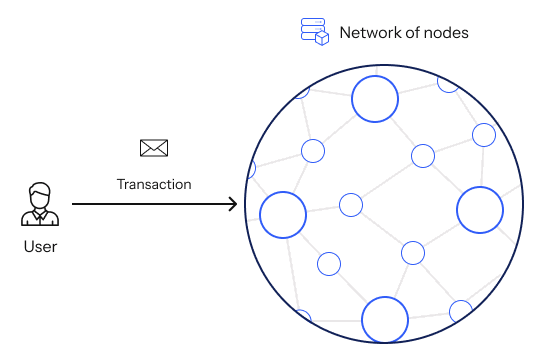The Platform Blockchain
A blockchain is a distributed and immutable ledger. "Distributed" means that the system is run by multiple computers. The blockchain manages data, where each computer holds a copy of the same data. The data stored is defined as the state of the blockchain. "Immutable" means that the history of the blockchain state cannot be altered.
Defining the blockchain state with smart contracts
Smart contracts are programs that define the type and format of the data stored on the blockchain. Each smart contract defines its own state. The combined state of all the smart contracts is the state of the blockchain. Smart contracts also define their own set of operations, which can change the state of the smart contract. These operations are called actions.
Changing the state by sending a transaction
A user can change the state of the blockchain, by creating and sending a transaction. A transaction specifies the contract to call and the action to execute. It is also signed by the user sending the transaction. The blockchain keeps track of all valid transactions, like a paper trail for all changes to the blockchain state.
Users and accounts
Each user have a private key which is used for signing transactions and a public key which can be used for verifying the signatures. The private key is usually stored securely in a wallet on the users device.
The blockchain keeps track of the account for each user. The account holds information about the user. An account is uniquely identified by a blockchain address, which is derived from the public key and is a long ID like this 00e72e44eab933faaf1fd4ce94bb57e08bff98a1ed.
Executing a transaction
The blockchain will check if the signature is valid before executing the transaction. The execution of the transaction will spawn an event, which will call the specified action on the target contract. Executing the event will update the state of the smart contract. If execution of an event fails, the state of the called smart contract will not be updated. The failure to execute the event is still saved by the blockchain.
Events spawned by events
Execution of an event can spawn new events for other contracts. Execution of the spawned events can again spawn new events and so forth. This allows a single transaction to modify the state of many smart contracts, because the smart contracts can communicate with each other through spawned events.
The computers, also called nodes, running the blockchain are located in different physical locations. Each of the nodes have their own copy of the contract states, so to make sure, that all changes are the same, all nodes execute the transactions and events in the same order.
The Flooding Network
To ensure that all nodes share all relevant information they are connected through a flooding network, which propagates the information received by any one node, to all the other nodes. The flooding process works by each node forwarding information to their immediate peers, and ensures that transactions received by one node are shared with all the other nodes in the network.
An example
A user sends a signed transaction to a node participating in the blockchain network. This node forwards the transaction to three immediate peer nodes that it is connected to. These nodes, in turn, propagate the transaction to the peer nodes they are connected to. This process continues until every node in the network has received the transaction.
Agreeing on the order of transactions and events
All nodes execute transactions and events in the exact same order to ensure that the state of the blockchain is consistent and deterministic.
At any given time a single node is selected as the current block producer.
The current block producer chooses a number of transactions and events, decides on an order and puts them into a "block". The proposed block is then flooded to all the other nodes. All the nodes check that proposed block is valid and execute the transactions and events in the order specified in the block.
The group of confirmed producer nodes in the network is called "the committee". Nodes in the committee take turn being the current block producer.
What is in a block?
- A unique "identifier", which is based on a hash of its contents.
- The identifier of the previous block (also called the parent block) used to keep track of the order of blocks.
- The list of transaction and events in the chosen order.
- The "block time" of the block which is a number that is incremented for each new block produced.
- The "production time" which is the UTC timestamp when the block was produced.
- The index of committee and the producer node that produced the block.
The consensus protocol
The mechanism, for selecting the next block producer, and proposing and accepting new blocks, is called a Consensus Protocol. The blockchain uses a custom made consensus protocol called FastTrack.
A full technical description of the FastTrack protocol is available here.
